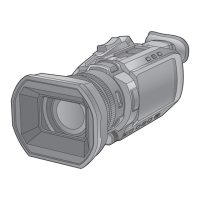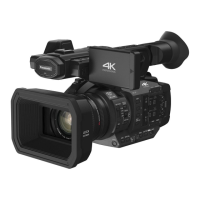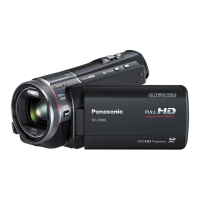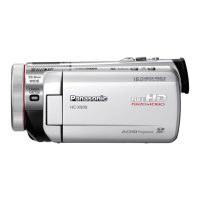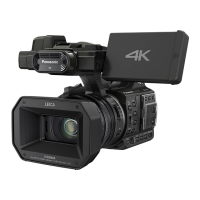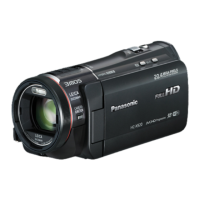Information for Your Safety
- 5 -
For the HC-X1500GT/HC-X2000GT
Battery Safety Precautions
1 Method of disposal
Disposal of used batteries should be in accordance with local laws and/or regulations.
2 Recommendations for end-users
≥ Secondary cells or batteries must not be disassembled, opened, or torn.
≥ Cells or batteries must not be exposed to heat or fire. Avoid storage under direct sunlight.
≥ Do not short circuit the cells or batteries. Please do not store cells or batteries in a box or drawer to avoid possible internal short circuit, or
short circuit caused by conductive materials.
≥ Please do not remove cells or batteries from the original package before use.
≥ Cells or batteries must not be exposed to mechanical impact.
≥ If a cell is leaking, the electrolyte must not come in direct contact with your skin or eyes. In case of accidental contact, please wash the
affected area with plenty of water and seek medical assistance.
≥ It is prohibited to use non-designated chargers.
≥ To ensure correct use, please pay attention to the positive (+) and negative (-) polarity labeled on the cells, batteries, as well as the device.
≥ Do not use any cell or battery which is not designed for use with the equipment.
≥ It is prohibited to mix cells of different brands, capacities, sizes, or models.
≥ Children should not handle cells/batteries without adult supervision.
≥ In case a cell or battery is accidentally swallowed, please seek medical assistance immediately.
≥ Be sure to use the batteries recommended by the device manufacturer.
≥ Cells and batteries should be kept clean and dry.
≥ When the terminal of a cell or battery is dirty, please wipe it with a dry, clean cloth.
≥ Secondary cells and batteries should be charged before use. Please use the correct charger and follow proper charging procedures in
accordance with the instructions provided by the cell/battery manufacturer or in the user's manual.
≥ When not in use, batteries should not be placed on charge for an extended period of time.
≥ After prolonged storage, several cycles of charging and discharging may be necessary for the cells or batteries to reach their maximum
efficiency.
≥ Please keep the original cell and battery documentation for future reference.
≥ Only use cells or batteries that are suitable for the intended purpose.
≥ If possible, remove all cells/batteries from the device when not in use.
≥ Cells/batteries should be properly disposed.
Emergency Treatment Methods
In order to prevent loss of life or personal property
for the user as well as others, please unplug the
power and stop using the device immediately
if you are experiencing any abnormalities.
Emergency Treatment Methods
To avoid danger and loss of life and property
to the user and others, remove the battery
and stop using the device if an abnormality
occurs.
Cell/battery type Secondary lithium batteries
Model No. AG-VBR59
Rated
value
Nominal voltage 7.28 V DC
Rated capacity 5900 mAh
Watt-hour rating 43 Wh
Charging current 4000 mA
Charging voltage 8.4 V
Charging time Approx. 5 hours 30 minutes (when using AC adaptor, charging environment: 25 oC 60%RH)
Charging temperature 10 oC to 30 oC
Country of Origin Made in China
For certified low-power radio-frequency devices, companies, enterprises, or users shall not change the frequency, enhance the power, or alter
the original features and functions of the design without approval. Low power radio-frequency devices shall not influence aircraft security and
interfere with legal communications. If any interference is found, the user shall cease operation immediately and improve it until there is no
interference before continuing to use the device. Legal communications in the preceding paragraph refer to radio communications conducted
in compliance with the Telecommunications Act. Low-power radio-frequency devices shall be resistant to the interference created by legal
communications or industrial, scientific, and medical radio wave electrical devices.
About medical
≥ Please consult any information about the manufacturers of personal medical devices, such as cardiac rhythm devices and hearing aids, to determine
whether these devices are indeed completely free from interference from external RF (radio frequency) radiation. (The frequency range of product
operation is between 2412 MHz and 2462 MHz, and the RF transmission power is 100 mW (maximum).)
≥ If the health care institution posts an instruction that the product cannot be used, do not use the product in the institution. Hospitals or healthcare
facilities may use equipment that is quite sensitive to external RF emissions.
Please recycle
used batteries
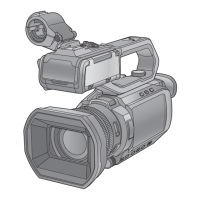
